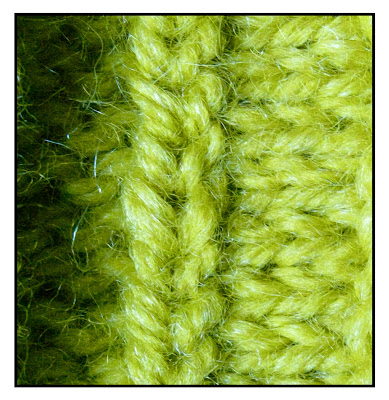Step 1: run a column of reverse stockinette (ie: purls) where you want to start the new fabric. You can either create this column of purls as-you-go, or insert it afterwards (possibly easier) by dropping a column and hooking it back up. When you flip the fabric over, this has created a single column of KNIT stitches on the reverse stockinette face of the fabric.
 |
| Step 1: on the reverse stockinette face of the fabric, you will have created a single column of knit stitches (darker green in illustration) |
Step 2: insert a small crochet hook SIDEWAYS into each stitch of this column and draw through a loop
 |
| Step 2: Using a crochet hook, draw loops through the column of knits as shown |
Step 3: Deposit each loop as it is made onto a knitting needle (circular or double pointed). You will now have a line of stitches picked up on the inside of the garment which magically seem to grow right out of the row of knits. You will not believe how completely and utterly invisible the pick up is--invisible from both sides of the fabric. (I've drawn it in pink here so you can see it, but when this is worked in the same color as the stockinette fabric, it disappears.)
Once your stitches are picked up, you simply knit away.
 |
| In the wool: the fabric to the right (at right angles to the line of knits) was picked up through the line of knits and created as described in this post |
A note on gauge--
Obviously, this method involves picking up one stitch for each row. Yet, this might make the fabric sag and gap, as row gauge is smaller than stitch gauge in knitting (more rows/in than sts/in). This is solved by using a smaller needle and knitting tighter, to bring the st gauge of the facing in line with the row gauge of the garment. If your yarn is too heavy for this trick, such that the resulting fabric would be too stiff, use a thinner yarn in matching color.
Addendum: Have a look at this post, where this sort of facing is used to face a steek. There are some very clear photos of what the inside of the facing--picked up by the "beautiful method"-- looks like. This also shows the gauge-reduction trick in action, so even if you are not interested in steeks, the photos at the steek post could shed light on this facing trick.
--TK


